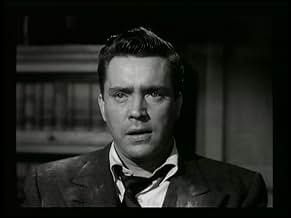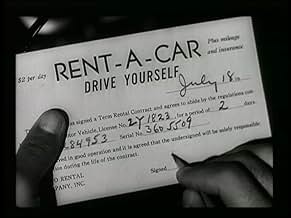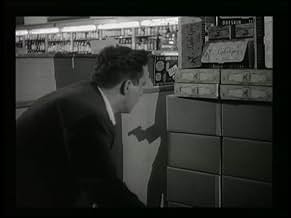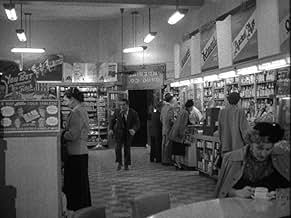Frank Bigelow, qui apprend qu'il a été empoisonné et qu'il ne lui reste que quelques jours à vivre, tente de découvrir qui l'a tué et pourquoi..Frank Bigelow, qui apprend qu'il a été empoisonné et qu'il ne lui reste que quelques jours à vivre, tente de découvrir qui l'a tué et pourquoi..Frank Bigelow, qui apprend qu'il a été empoisonné et qu'il ne lui reste que quelques jours à vivre, tente de découvrir qui l'a tué et pourquoi..
- Réalisation
- Scénario
- Casting principal
- Récompenses
- 2 victoires au total
- Miss Foster
- (as Beverly Campbell)
- Sue
- (as Cay Forrester)
- Dr. Matson
- (as Fred Jaquet)
- Dr. Schaefer
- (as Larry Dobkin)
- St. Francis Hotel Desk Clerk
- (non crédité)
Avis à la une
It's an exciting B-thriller of vibrating pace that unites various elements as the fatalism , cynicism , corruption with a noir vision of America from the time . The original title belongs the notes about the deceased person . Magnificent interpretation by usually secondary Edmond O'Brien as when he is frantically running by San Francisco streets . The scene in which he runs in panic through the streets after learning he has been poisoned was a stolen shot . The pedestrians had no idea a movie was being made and no warning that Edmond O'Brien would be plowing through them . Nice secondary cast , being film debut of Beverly Garland and Neville Brand . The film gets a good black and white (though available colorized) cinematography with some excellent close-ups (the jazzmen) by Ernest Lazslo . Atmospheric music by the classic Dimitri Tiomkin . The movie is well done by Rudolph Mate , a famous and habitual cameraman . It's followed by inferior remakes as ¨Color me dead¨ (1969) with Tom Tryon and 1988 version with Dennis Quaid and Meg Ryan . The motion picture will appeal to dark noir movies fans . Rating : Notable and well worth seeing.
It took a while for Bigelow to realize that he had a fatal dose of luminous toxin in his system and by the time he did it was too late to save his life. But it wasn't too late for Bigelow to track down and find the person or persons who had him poisoned. And it's during the rest of the movie, in flashback, that's exactly what he did! And did it with an unrelenting fury as if his life depended on it!
In what is undoubtedly Edmound O'Brien's best role as Frank "Biggie" Bigeow the film "D.O.A" has him move heaven and earth to find the person who eventually murdered him. From San Francisco to Los Angeles as well as parts in between Bigelow finally track him down to the Philips Inport-Export office at the Bradbury Building in downtown L.A. It in fact was Philips who was murdered, by being thrown to his death, because of the illegal iridium shipment that he later realized he was tricked into handling. With Philips dead the only person who could connect both his murderer and the person whom he shipped the iridium for is Frank Bigelow who handled, by notarizing the bill of sale, the shipment!
Non stop action thriller as a dying, or murdered, man turns L.A upside down in trying to find his killer and exact punishment on him before he himself expires! Bigelow also gets involved with L.A mobster Majak, Luther Adler, whom the illegal iridium was delivered for. In knowing about Majak's involvement in it had Bigelow targeted by him and his sadistic and unstable hit man Chester, Naville Brand, for immediate termination. That's if the luminous toxin doesn't kill him first!
Even though the movie is a scant 83 minutes long it packs enough action to fill some half dozen films of it's type: Film Noir Thrillers. Frank Bigelow is a man who knows that he hasn't long to live and therefore throws caution to the wind in trying to find his killer before the curtain comes down on him. It was in fact that almost suicidal determination on Bigelow's part that in the end brought him results!
This memorable key scene portends his disconnection from those around him and represents a crack, however slight, in his life's foundation. Though initially reticent about socializing and imbibing with people he just met, he has unwittingly been thrust into a reality more threatening than is immediately apparent. Later in the film, a jarring example of his full blown isolation occurs when he finds himself in an outdoor, public area. In unbearable turmoil, he momentarily encounters a little girl innocently playing with a toy. She appears in soft lighting, contrasting starkly to the shadows surrounding Bigelow, whose face registers the painful shock of awareness that ordinary activity continues unabated even while he grapples with extreme danger. This is reinforced when seconds later he observes a young couple embracing, compounding his agonizing realization that all simple pleasures are now unattainable to him. Noticeably, when he is literally "up against the wall" his back is touching signage of "Life Magazine" logos. All that once comprised his own life, that which he had considered to be little more than mundane minutiae, is heightened in significance and irrevocably at stake.
It starts with a bang, O'Brien staggering into the local homicide unit to tell the cops that there's been a murder - his, before launching into the massive flash-back which takes up pretty much the rest of the movie. The action from there on is hectic and as convoluted as all the best noirs are as O'Brien, infected by a deadly poison, races against the clock to track down his own killer and the reason behind it.
The film makes fine use of actual San Francisco and Los Angeles locations as well as authentically depicting the hot and steamy atmosphere at a Frisco jazz club. O'Brien is great as the doomed Bigelow, racing, often literally, against the clock, stopping only to palm off his adoring secretary girl-friend, Pamela Britten, who of course doesn't find out what's wrong with him until too late.
The pacing is almost non-stop once it gathers momentum, unfortunately when it does, some of the scene-writing gets over-ripe and correspondingly over-acted as O'Brien and his girl pour out their hearts somewhat unnecessarily. The film ends bravely though with a downbeat conclusion, delivering what the title says it must and at least tying up all the loose ends by that time.
It's a story about how a simple act can lead to disaster in this case, death. If you've not seen it, I'm not about to tell you much except this: it has perhaps the most imaginative beginning for any murder mystery ever devised as Frank Bigelow (Edmond O'Brien) fronts up to the Homicide Bureau in Los Angeles to report a murder his own! Thereafter, the story traces Frank's attempts to find out who is trying to kill him, and why. One of the best pieces of irony is when, having learnt that he will die soon, Frank runs and runs until he's out of breath and stops, panting, beside a newsstand where there are multiple copies of Life magazine hanging there, just beside him. The director, Rudolph Mate, had a real insider joke with that shot.
And that long tracking shot, by the way, was an excellent example of how to use fast camera work and great editing.
On another level, the movie very much fits the times vis-à-vis the portrayal of evil and where it leads: retribution is always just around the corner for those who transgress society, even if you think you're justified. When you see this movie, you'll know what I mean.
And, for the times, the acting was good, with a standout performance from Edmond O'Brien, and ably supported by the ever-competent Luther Adler (as Majak, the sharp dealer in stolen goods), and Neville Brand, as the psychopathic Chester. The rest of the cast was adequate. The only jarring note (no pun intended) are the peculiar and bizarre wolf-whistles (inserted by some demented sound engineer?) that accompany Frank Bigelow as he looks at women in his hotel at San Francisco. What was the director thinking of...?
That aside, it's a good, fast-paced action mystery that helped to keep the film noir genre very much alive. Have a go...
Le saviez-vous
- AnecdotesThe scene in which Bigelow runs in panic through the streets after learning he has been poisoned was what is considered a 'stolen shot' where the pedestrians along the sidewalk had no idea a movie was being made and no warning that Edmond O'Brien would be plowing through them.
- GaffesAfter finding out who's in the photo, Bigelow leaves the photography studio and immediately starts getting shot at. He heads toward the factory (screen right) where the shots are supposed to be coming from, but all the shots being fired and ricocheting off the ground, pipe, barrel, etc. are coming from the other direction (screen left).
- Citations
[first lines]
Homicide Detective: Can I help you?
Frank Bigelow: I'd like to see the man in charge.
Homicide Detective: In here...
Frank Bigelow: I want to report a murder.
Homicide Captain: Sit down. Where was this murder committed?
Frank Bigelow: San Francisco, last night.
Homicide Captain: Who was murdered?
Frank Bigelow: I was.
- Crédits fousThe end credits read "The medical facts in this motion picture are authentic. Luminous toxin is a descriptive term for an actual poison. Technical Adviser, Edward F. Dunne, M.D."
- Versions alternativesAlso available in a colorized version.
- ConnexionsEdited into Déjà-vu (2000)
Meilleurs choix
- How long is D.O.A.?Alimenté par Alexa
Détails
- Date de sortie
- Pays d’origine
- Langue
- Aussi connu sous le nom de
- Bon pour la morgue
- Lieux de tournage
- Sociétés de production
- Voir plus de crédits d'entreprise sur IMDbPro
- Durée
- 1h 23min(83 min)
- Couleur
- Rapport de forme
- 1.37 : 1

























